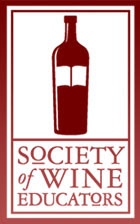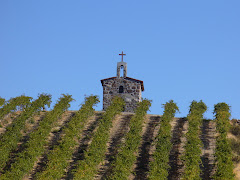One of the most difficult things I have to do on this job is research, for no other reason than it is extremely time-consuming. Some of my distributors unfortunately, forget that time is a rare and valuable commodity in this world, so I have to make extraordinarily informed decisions in less than a weekend. Which is nice, because I love having to run through a crowd of people, naked and blindfolded… Research plays a huge roll in my work, and none more so than in what we affectionately refer to as “direct importing” or “pre-sales.” This action takes place when a distributor, representing a specific importer, offers either annually or bi-annually, the bulk of said importer’s portfolio, whereas throughout the year, only a small portion of that importer’s goods are supplied. We do a lot of this with importers such as Frederic Wildman, Palm Bay Imports, T.G.I.C. Importers, etc. Yet the most arduous research comes when it’s time to put together a Terry Theise order.
Terry Theise is a world-renowned figure in the wine industry as a leading importer of German, Austrian and “grower” Champagnes, and every year, he generates texts for each area that are chock full of information about the vintage, the wineries, and insight into which selections he feels are the most noteworthy. It’s a long and lengthy read – close to 100 pages, and that takes time, even for a speed reader like myself. For the first time, I am now afforded the time it takes to wade through the information, thanks to Terry Theise being represented by a new distributor for us in Kentucky – Vanguard Wines. The previous distributor would give me maybe 2 or 3 days to read up on all of Theise’s notes and make an informed decision – one that would affect my inventory for 6 months. That is not a lot of time, to be sure. And the fact that Terry Theise, as one of my English Lit professors from college would say, is a “heck of a good writer,” I usually was stuck with something too difficult to sell, or perhaps too expensive.
So today, I was able to sit down and read through his Austria 2008 report, and make determinations on how to expand upon my miniscule Austrian section in the store (which constitutes a total of 5 selections). Knowing that Austria is such an “undiscovered country” for our clientele, here are the selections I chose, and why I chose them:
1. Prieler Chardonnay Ried Sinner 2007. For starters, Austrian Chardonnay. Hmm. Interesting to say the least. This promises to be the antithesis for those California “butterbomb” Chards that everyone has drank to death. Just a clean, crisp Chardonnay with loads of appley minerality.
2. Heidi Schrock Furmint 2007. The grape variety made famous by Hungary’s Tokaji, this according to Mr. Theise is “…slow to unfold, but gorgeous once it does. Classic rosewater and quince aromas lead into a marvelously silky and spicy palate; both yielding and firm; peony notes to an atmospheric and sweet-toned wine.” Should be a lot of fun for the sweet wine fans.
3. Heidi Schrock Muscat 2007. This is actually a blend of Gelber Muskateller, Ottonel and Sauvignon which, according to Theise, has a “multi-faceted spicy aroma and a lively and precise palate.”
4. Walter Glaetzer Zweigelt “Rubin Carnuntum” 2006. An Austrian red, this is a cross between two indigenous Austrian varietals – Blaufrankisch and St.-Laurent. With lots of juicy cherry and plum fruit and hints of cinnamon and soy, this unique red is almost ideal for Asian meats.
5. Setzer Riesling 2007. What caught my eye right away was how Theise states in his report that 2007 Austrian Rieslings were fantastic, and what tipped me off about this particular Riesling was that he called it “the single best Riesling VALUE in this offering.” That’s a bold statement. And though most importers toot their own horn a lot to little avail, Mr. Theise hasn’t steered me wrong in over the last 10 years I have been familiar with his wines.
6. Ecker Gelber Muskateller 2007. Now we are talking Muscat, and the whole description of “elderflowers and nutmeg” caught my attention. These wines are only slightly sweet, with more spicy zip and zang that lends it to be a bit more adventurous.
7. W. Brundlmayer Gruner Veltliner “Kamptal Terrassen” 2007. This one is more a “reload” of a really nice, full-bodied, dry white wine that continues to impress me. Brundlmayer is one of the top producers in Austria and this is considered his flagship offering.
8. L. Heidler Gruner Veltliner “November” 2007. I opted to put one GruVe in that would offer a bit more complexity and substance, an ageworthy GruVe that would really impress. Remarkably, even the inexpensive Gruners have the potential for aging at least 5-10 years. This one, you could maybe shoot for 20? 30? Who knows.
9. Hirsch Gruner Veltliner “Veltliner #1” 2007. Considered by Thiese as one of the best “cheap GruVes he’s ever offered, he raves about its ripe, even aromas, length of texture and solid finish.
10. Hirsch Riesling Zobing 2007. Also a reload, this is a beautiful, DRY Riesling that would really make all the naysayers stand up and take notice.
Austria arguably makes some of the world’s greatest dry white wines, and with the majority of the producers being certified organic, all the trendy points are there. But aside from all of that, Austria produces white wines that even the die-hard red drinkers can appreciate and enjoy. It’s high time that American consumers realize this, because hands-down, Austria producers some of the best values in wine, in relation to what’s going in the bottle, in the world. These wines are ideal for the foods we as Americans most love to eat. They are complimentary, not overbearing, and are not high in alcohol or residual sugar. There is structure, finesse and body, without sacrificing one for the other.
Aside from the Hirsch Riesling and the Brundlmayer, these wines will be due in sometime in September so look for them. And if you get the chance to try any Austrian wines between now and then, do so, and enjoy.
Subscribe to:
Post Comments (Atom)








No comments:
Post a Comment